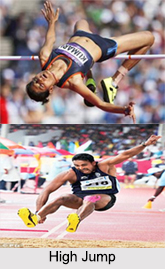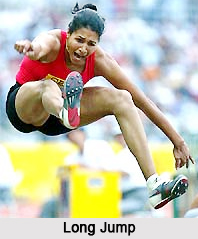 Field events are popular among the Indian spectators. These filed events in Indian athletics can be categorized into many types. High jump, cross bar, pole vault, triple jump and long jump are considered among the most popular in field events.
Field events are popular among the Indian spectators. These filed events in Indian athletics can be categorized into many types. High jump, cross bar, pole vault, triple jump and long jump are considered among the most popular in field events.
In field events, there is a qualifying competition for which a standard is set. All those who qualify earn the right to appear in the final. If less than 12 qualify, the number is made up to 12. The finalists in the long jump, triple jump and four throws have 3 trials each. The leading 8 then earn 3 more trials.
High jump in Indian Athletics
The minimum length of the runway of high jump is 15 metres. The take off must be from one foot and the bar must be cleared. Crossing under the bar counts as a failure. There are three consecutive failures at any height disqualify a competitor. In case of a tie, the winner is the competitor with the fewest jumps at the tying height. If still equal, the winner will be the one with the fewest failures at any height. If a tie persists it is only to be broken for the first place. The competitors shall have one jump at the height at which they failed. And if there is still no decision then bar shall be lowered and raised until the tie is broken. The landing area should measure not less than 5 m long and 3 m wide.
Cross Bar in Indian Athletics
 The length of a cross bar is 3.98 m to 4.02 m. The weight of cross bar should not be more than 2 kg. The supports for it should be flat and rectangular having 60 mm length and 40 mm width. The distance between uprights must be 4 -4.04 m
The length of a cross bar is 3.98 m to 4.02 m. The weight of cross bar should not be more than 2 kg. The supports for it should be flat and rectangular having 60 mm length and 40 mm width. The distance between uprights must be 4 -4.04 m
Pole Vault in Indian Athletics
Pole vault is probably a refinement of pole-jumping, a practice employed for many centuries in the Fen district of England for crossing marshy patches of ground. Competitive jumping can be traced back to the mid-nineteenth century in Ulverston, Lancashire. The minimum length provided for the runway shall be 40 m. The landing area should not measure less than 5 m x 5 m. A large inflated cushion (air bed) has been introduced for the landing area. The length of the cross bar should be between 4.48 m and 4.52 m. The maximum weight permissible for the bar is 2.25kg. Pegs are used for supporting the cross bar and should be without notches or indentations of any kind. They should be of uniform thickness and not have more than 13 mm (I/2 in) diameter. They must not extend more than 75 mm (3 in) from the uprights. Cross bar rests on them in a fashion that if a competitor or his pole touches it, it will fall easily to the ground in the direction of the landing area.
Vaulting Pole in Indian Athletics
The pole may be of any material or combination of materials. The pole may have a binding only of two layers of adhesive tape of uniform thickness. Since 1962, the use of fibreglass has revolutionised the event.
A competitor is allowed three trials at each height. He fails if he:
(a) Takes off and fails to clear the bar,
(b) Knocks off the bar,
(c) Shifts his hands on the pole after take off, or
(d) Crosses the plane of the uprights with either his body or the pole.
 A pole that passes under the bar after take off does not spoil a jump. The ties are broken in a similar manner as in high jump.
A pole that passes under the bar after take off does not spoil a jump. The ties are broken in a similar manner as in high jump.
Long Jump in Indian Athletics
The take off board of long jump is 198 to 202 mm wide and 1.21 m to 1.22 m long. The edge of the board, which is nearer to the landing area, is called the take off line. All jumps are measured from the take off line to the nearest break in the landing area. The landing area should have a minimum width of 2.75 m. The distance from the take off and the end of the landing area should be at least 10 m. The take off board should not be less than one meter from the edge of the landing area.
The jump shall be counted as failure if the competitor:
(a) Touches the ground beyond the take off line,
(b) After a completed jump, walks back through the landing area.
Triple Jump in Indian Athletics
The general rules for triple jump are the same as for long jump except that in the "hop" the competitor must land on the same foot that he took off from and during "step" land on the other foot. The distance between the take-off board and the far end of the landing area shall be at least 21 meters.




